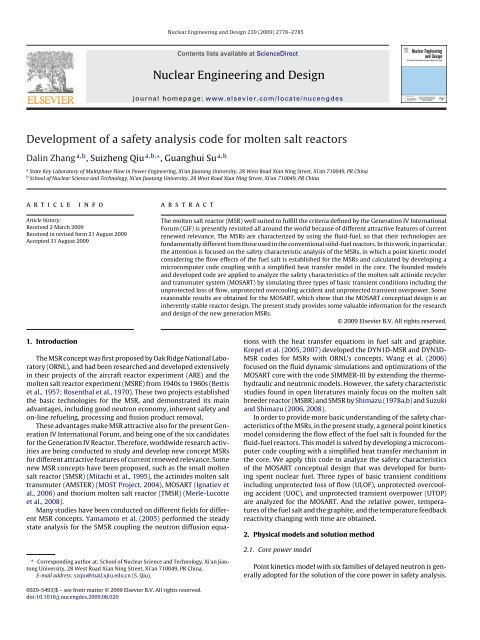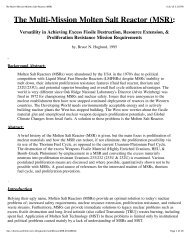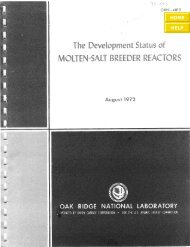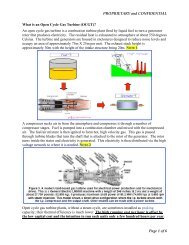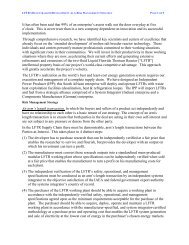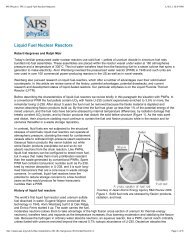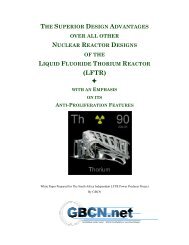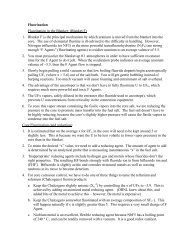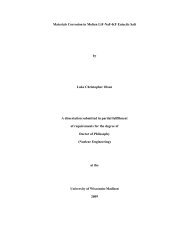Development of a safety analysis code for molten salt reactors
Development of a safety analysis code for molten salt reactors
Development of a safety analysis code for molten salt reactors
You also want an ePaper? Increase the reach of your titles
YUMPU automatically turns print PDFs into web optimized ePapers that Google loves.
2780 D. Zhang et al. / Nuclear Engineering and Design 239 (2009) 2778–2785where bulk is the viscosity at the bulk temperature, and surf isthat at the surface temperature. In this calculation the fuel <strong>salt</strong>temperature is used as the bulk temperature, while the graphitetemperature is as the surface temperature.The reactivity feedback caused by the temperature (labeled bysubscript T) changes <strong>of</strong> the fuel <strong>salt</strong> and the graphite reflector isspecially considered: T (t) = ˛f∑Mf,i (T f,i − T f 0,i )∑Mf,i+ ˛g∑Mg,i (T g,i − T g0,i )∑Mg,i(9)where subscript i denotes the number <strong>of</strong> the control volume in thecalculation; and subscript 0 presents the parameter at the ratedstate.2.4. Solution methodFor the initial steady state conditions, the rated power is givento the neutron density. The initial delayed neutron precursors inthe core and in the loop, and the temperatures in the fuel <strong>salt</strong> andgraphite can be obtained by Eqs. (2)–(5) with the time-dependentterms being set to zero.The transient characteristics <strong>of</strong> the reactor at a given initialsteady state are obtained by solving the set <strong>of</strong> non-linear ordinarydifferential equations with different perturbation conditions, suchas the loss <strong>of</strong> flow, the overcooling at the inlet, and the overpower.The set <strong>of</strong> ordinary differential equations founded <strong>for</strong> the fluid-fuel<strong>reactors</strong> can be written asd⃗ydt = f (t, ⃗y, ⃗y′ ,x) (10)⃗y(t 0 ) = ⃗y 0 (11)where ⃗y is the state vector <strong>for</strong> the calculated variables, such as theneutron density, the precursors concentrations and the temperatures.We applied the Gear method (Gear, 1971) equipped with Adamspredictor–corrector method, which designed especially <strong>for</strong> stiffequation system to solve the set <strong>of</strong> equations.3. Results and discussionThe theoretical models and the solution method have been<strong>code</strong>d in modular structure and applied to the MOSART, which canbe easily modified to be competent <strong>for</strong> the calculations under differenttransient conditions <strong>of</strong> the MOSART even other kinds <strong>of</strong> MSRsor fluid-fuel <strong>reactors</strong>. In this work, three types <strong>of</strong> basic transients,including the unprotected loss <strong>of</strong> flow (ULOF), unprotected overcooling (UOC), and unprotected transient overpower (UTOP) areanalyzed.3.1. General description <strong>of</strong> the MOSART conceptThe MOSART concept is proposed by RRC-KI, and studied withinthe coordinated research project (CRP) framework <strong>of</strong> IAEA to examineand demonstrate the feasibility <strong>of</strong> <strong>molten</strong> <strong>salt</strong> <strong>reactors</strong> to reducelong lived waste toxicity and to produce efficiently electricity inclosed cycle. The MOSART fuel circuit and reactor configuration arerepresented in the references (Ignatiev et al., 2006; Maschek et al.,2008). Here, the reactor configuration is displayed in Fig. 1, and thebasic parameters are listed in Table 1.3.2. Analysis <strong>of</strong> unprotected loss <strong>of</strong> flow (ULOF)Presuming that the ULOF is initiated by the loss <strong>of</strong> <strong>for</strong>ced circulationsin primary system due to pump failure, in which the massflow rate decreases to 4% <strong>of</strong> the rated flow in 7 s as shown in Fig. 2 byFig. 1. Reactor configuration <strong>of</strong> the MOSART.the circle symbols, and the inlet temperature <strong>of</strong> the fuel <strong>salt</strong> keepsconstant (see the triangle symbols in Fig. 3) in calculation.The loss <strong>of</strong> flow results in two effects. The first effect is the reduction<strong>of</strong> the loss <strong>of</strong> delayed neutrons from the core, which introducesabout 82.9 pcm insertion <strong>of</strong> positive reactivity. The second effect isthe increase <strong>of</strong> the temperatures in the core. Fig. 3 displays thetemperatures <strong>of</strong> the fuel <strong>salt</strong> and the graphite changing with time,from which, it can be observed that both fuel average and fuel outlettemperatures rise rapidly to about 740 ◦ C and 870 ◦ C at about 40 sinto the transient, while the average temperature <strong>of</strong> the graphiteincrease a little because <strong>of</strong> its thermal inertia. The temperaturesincrease generates strong negative reactivity insertion because <strong>of</strong>the negative reactivity coefficients <strong>of</strong> the fuel <strong>salt</strong> and the graphite.Fig. 4 shows the reactivity feedback caused by the temperatures<strong>of</strong> the fuel <strong>salt</strong> and the graphite, from which it can be seen thatthe reactivity caused by the increase <strong>of</strong> the fuel <strong>salt</strong> temperaturequickly decreases to the minimum value, while that caused by theTable 1Basic parameters <strong>of</strong> the MOSART.ParametersValuesCore diameter/height (m) 3.4/3.6Core nuclear power (MW) 2,400Core <strong>salt</strong> mass flow rate (kg/s) 10,000Fuel <strong>salt</strong> mass in the core (kg) 69,914Fuel <strong>salt</strong> mass in the external loop (kg) 39,376Graphite mass in the core (kg) 20,000Fuel <strong>salt</strong> volume in the core (m 3 ) 32.67Fuel <strong>salt</strong> volume in the external loop (m 3 ) 18.4Core inlet temperature ( ◦ C) 600Core outlet temperature ( ◦ C) 715Graphite temperature ( ◦ C) 770Reactivity coefficient <strong>of</strong> the fuel temperature (pcm/K) −4.125Reactivity coefficient <strong>of</strong> the graphite temperature (pcm/K) −0.04
D. Zhang et al. / Nuclear Engineering and Design 239 (2009) 2778–2785 2781Fig. 2. Relative power and flow in the ULOF.Fig. 5. Temperatures in the UOC.level to that <strong>of</strong> the flow drop. Fig. 2 displays the relative power bythe square symbols. The power decrease makes the temperature <strong>of</strong>the fuel <strong>salt</strong> in the core decreases and stabilizes to near the initiallevel, and the reactivity increases correspondingly.3.3. Analysis <strong>of</strong> unprotected overcooling accident (UOC)Fig. 3. Temperatures in the ULOF.graphite temperature decreases little, there<strong>for</strong>e, the total reactivitycaused by the temperatures mainly dependent on the temperature<strong>of</strong> the fuel <strong>salt</strong>. The rapid negative reactivity feedback by the temperaturesincrease balances the positive reactivity insertion by theloss <strong>of</strong> flow, the net effect <strong>of</strong> which is a fast decrease in the powerIn this case, the inlet temperature <strong>of</strong> the fuel <strong>salt</strong> is postulated todecrease 100 ◦ C in 60 s (see triangle symbols in Fig. 5) to simulatethe UOC accident, and the mass flow remains constant as shown inFig. 6 by circle symbols.The inlet temperature decrease leads to a little decrease <strong>of</strong> theaverage temperature <strong>of</strong> the fuel <strong>salt</strong> whereas the outlet temperature<strong>of</strong> the fuel <strong>salt</strong> increases from 720 ◦ C to 820 ◦ C, which aredisplayed in Fig. 6. Because the reactivity coefficient <strong>of</strong> the fuel <strong>salt</strong>is negative, a positive reactivity feedback caused by the fuel <strong>salt</strong> isintroduced into the reactor as shown in Fig. 7, which results in thepower increasing to 2.7 times <strong>of</strong> its rated value as shown in Fig. 5.From Fig. 6, it also can be found that the average graphite temperatureincreases gradually, which inserts negative reactivity feedbackto balance the positive reactivity introduced by the fuel <strong>salt</strong> leadingto the power and the fuel <strong>salt</strong> temperature stabilized.Fig. 4. Temperature reactivity feedback in the ULOF.Fig. 6. Relative power and flow in the UOC.
2782 D. Zhang et al. / Nuclear Engineering and Design 239 (2009) 2778–2785Fig. 7. Temperature reactivity feedback in the UOC.Fig. 9. Temperatures in the UTOP with +200 pcm jump.3.4. Analysis <strong>of</strong> unprotected transient overpower (UTOP)In MSRs, the fuels are generally dissolved in the <strong>molten</strong> <strong>salt</strong>s tobe fluid phase. If the agglomerated fuels are poured into the reactor(which can stay in the core (called reactivity jump), or cycle in theprimary loop (called reactivity cycle)), the positive reactivity willbe introduced directly and leads to overpower transients.In the first calculated case <strong>of</strong> UTOP, +200 pcm (about 60 cent)reactivity <strong>of</strong> the fuel agglomeration is assumed to be added intothe core by a step. The flow and the inlet temperature remain thenominal values in the calculation as shown in Figs. 8 and 9.The relative power, temperatures and reactivity feedbackcaused by temperatures are shown in Figs. 8–10, respectively. FromFig. 8, it can be found that a power pulse <strong>of</strong> about 4 times <strong>of</strong> thenominal power is generated in short time because <strong>of</strong> the positivereactivity insertion. Correspondingly, the temperatures <strong>of</strong> the fuel<strong>salt</strong> raise quickly, which leads negative reactivity feedback addinginto the core fast. There<strong>for</strong>e, the power decreases to 1.7 times <strong>of</strong> thenominal value, and the average temperature and the outlet temperature<strong>of</strong> the fuel <strong>salt</strong> stabilizes at 700 ◦ C and 800 ◦ C after increasingin the initial phase. Concurrent with the initial fast increase <strong>of</strong>the fuel <strong>salt</strong> temperature, the average temperature <strong>of</strong> the graphiteincreases very slowly and generates small reactivity feedback.The second calculated case <strong>of</strong> UTOP is assumed to be caused by afuel agglomeration (+200 pcm) sweeping through the core region inFig. 10. Temperature reactivity feedback in the UTOP with +200 pcm jump.about 7 s and returning in another loop time (about 4 s). In the calculation,the flow and inlet temperature have no changes. Figs. 11–13shows the calculated results.From Figs. 11–13, it can be found that the relative power, theaverage and outlet temperatures <strong>of</strong> the fuel <strong>salt</strong> and the reactiv-Fig. 8. Relative power and flow in the UTOP with +200 pcm jump.Fig. 11. Relative power and flow in the UTOP with +200 pcm cycle.
D. Zhang et al. / Nuclear Engineering and Design 239 (2009) 2778–2785 2783Fig. 12. Temperatures in the UTOP with +200 pcm cycle.Fig. 14. Relative power and flow in the UTOP with +500 pcm jump.ity feedback caused by the fuel <strong>salt</strong> temperatures changing varyperiodically, which is corresponding with the cyclical reactivityinsertion initiated by the fuel agglomeration cycle. And in everyperiod, the changing trends are similar with those in the first case<strong>of</strong> UTOP. However, it can be observed that the power peaks followingthe first power peak are lower, that is because their initialpowers are a little lower. Fig. 13 shows that the reactivity feedbackcaused by the fuel <strong>salt</strong> is still negative in the loop time, which leadsthe relative power lower than the rated value in the loop time. Inaddition, the average temperature <strong>of</strong> the graphite change little dueto its thermal inertia, the reactivity feedback caused by which isnearly zero.Another two similar cases are also calculated, in which the reactivity<strong>of</strong> the fuel agglomeration is +500 pcm (about 1.5 dollar).Figs. 14–16 display the results under the condition <strong>of</strong> +500 pcmreactivity jump, and Figs. 17–19 shows those <strong>of</strong> +500 pcm reactivitycycle.From Fig. 14, it can be seen that the insertion <strong>of</strong> +500 pcm reactivityleads to a power pulse in very short time, the factor <strong>of</strong> whichrelated to the rated power is nearly 500. The average and outlettemperatures <strong>of</strong> the fuel <strong>salt</strong> respond to the power pulse veryquickly and increase to 775 ◦ C and 950 ◦ C. The strong negative reactivityfeedback generated by the fuel <strong>salt</strong> makes the relative powerdecrease and stabilize at about 3, and the average and outlet temperatures<strong>of</strong> the fuel <strong>salt</strong> stabilize to 770 ◦ C and 940 ◦ C. In this case,Fig. 15. Temperatures in the UTOP with +500 pcm jump.the outlet temperature <strong>of</strong> the fuel <strong>salt</strong> reaches a maximum value <strong>of</strong>970 ◦ C, which is lower than the <strong>safety</strong> limited value (1400 ◦ C, theboiling temperature <strong>of</strong> the fuel <strong>salt</strong>). Similarly with the two casesabove, the average temperature <strong>of</strong> the graphite has little change inthis transient condition.Fig. 13. Temperature reactivity feedback in the UTOP with +200 pcm cycle.Fig. 16. Temperature reactivity feedback in the UTOP with +500 pcm jump.
2784 D. Zhang et al. / Nuclear Engineering and Design 239 (2009) 2778–27854. ConclusionFig. 17. Relative power and flow in the UTOP with +500 pcm cycle.In this present research, a general point kinetic model consideringthe flow effects <strong>of</strong> the fuel <strong>salt</strong> is established <strong>for</strong> the<strong>molten</strong> <strong>salt</strong> <strong>reactors</strong>, and solved by developing a microcomputer<strong>code</strong> coupling with a simplified heat transfer model inthe core. The founded models and developed <strong>code</strong> are appliedto analyze the <strong>safety</strong> characteristics <strong>of</strong> the MOSART. Three types<strong>of</strong> basic transient conditions including the unprotected loss <strong>of</strong>flow, unprotected overcooling accident and unprotected transientoverpower are analyzed. The results show that the MOSART conceptualdesign is an inherently stable reactor design because <strong>of</strong>its strong negative reactivity coefficient <strong>of</strong> the fuel <strong>salt</strong> temperaturein combination with its negative temperature coefficient <strong>of</strong>the graphite. All calculated transient conditions have no seriouschallenge to the MOSART even the UTOP with up to 1.5 dollarsreactivity insertion. Because <strong>of</strong> the adoption <strong>of</strong> modular programmingtechniques, this <strong>code</strong> is expected to be applied to transient<strong>analysis</strong> <strong>of</strong> other types <strong>of</strong> <strong>molten</strong> <strong>salt</strong> <strong>reactors</strong> or fluid-fuel <strong>reactors</strong>.AcknowledgementsThis work is carried out under the financial support <strong>of</strong>the National Natural Science Foundation <strong>of</strong> China (Grant No.10575079). And the authors also wish to acknowledge Dr. W.Maschek, Dr. S. Wang, and Dr. A. Rineiski, <strong>of</strong> the Institute <strong>for</strong> Nuclearand Energy Technologies (IKET) <strong>of</strong> Forschungszentrum Karlsruhe(FZK) <strong>for</strong> their valuable supports and comments.ReferencesFig. 18. Temperatures in the UTOP with +500 pcm cycle.The results <strong>of</strong> +500 pcm reactivity cycle (as shown in Figs. 17–19)illustrate that the relative power, the average and outlet temperatures<strong>of</strong> the fuel <strong>salt</strong>, and the reactivity feedback caused by fuel <strong>salt</strong>vary periodically, the trends <strong>of</strong> which in every period are similarwith those in the case <strong>of</strong> +500 pcm jump. The phenomenon thatthe power peaks following the first one are lower is also observed,and can be interpreted as done in the second case <strong>of</strong> UTOP.Fig. 19. Temperature reactivity feedback in the UTOP with +500 pcm cycle.Bettis, E.S., Schroeder, R.W., Cristy, G.A., et al., 1957. The aircraft reactorexperiment—design and construction. Nucl. Sci. Eng. 2, 804–825.Gear, C.W., 1971. Numerical Initial Value Problems in Ordinary Differential Equation.Prentice-Hall, Englewood Cliffs, pp. 126–187.Ignatiev, V., Afonichkin, V., Feynberg, O., et al., 2006. Progress in integratedstudy <strong>of</strong> <strong>molten</strong> <strong>salt</strong> actinide recycler and transmuter system. In: Proc.Ninth In<strong>for</strong>mation Exchange Meeting on Actinide and Fission Product Partitioningand Transmutation, France, September 25–29, 2006, Nuclear EnergyAgency.Krepel, J., Grundmann, U., Rohde, U., 2005. DYN1D-MSR dynamics <strong>code</strong> <strong>for</strong> <strong>molten</strong><strong>salt</strong> <strong>reactors</strong>. Ann. Nucl. Energy 32, 1799–1824.Krepel, J., Grundmann, U., Rohde, U., 2007. DYN3D-MSR spatial dynamics <strong>code</strong> <strong>for</strong><strong>molten</strong> <strong>salt</strong> <strong>reactors</strong>. Ann. Nucl. Energy 34, 449–462.Maschek, W., Stanculescu, A., Arien, B., et al., 2008. Report on intermediateresults <strong>of</strong> the IAEA CRP on ‘Studies <strong>of</strong> advanced reactor technology options<strong>for</strong> effective incineration <strong>of</strong> radioactive waste’. Energy Conver. Manag. 49,1810–1819.Merle-Lucotte, E., Heuer, D., Allibert, M., et al., 2008. Optimization and simplification<strong>of</strong> the concept <strong>of</strong> non-moderated thorium <strong>molten</strong> <strong>salt</strong> reactor. In: Proc. PHYSOR2008, Interlaken, Switzerland, September 14–19.Mitachi, K., Yamana, Y., Suzuki, T., Furukawa, K., 1995. Neutronic examination onplutonium transmutation by a small <strong>molten</strong>-<strong>salt</strong> fission power station. IAEA-TECDOC-840, 183–193.MOST Project, 2004. Reactor physics study, design review and nominaloperating conditions, non-proliferation issues. Final MOST-Project Report,Brussels.Rineiski, A., Sinitsa, V., Maschek, W., et al., 2005. Kinetics and cross-section developments<strong>for</strong> analyses <strong>of</strong> reactor transmutation concepts with simmer. In: Proc.Mathematics and Computation, Supercomputing, Reactor Physics and Nuclearand Biological Applications, Avignon, France, September 12–15, 2005, AmericanNuclear Society.Rosenthal, M.W., Kasten, P.R., Briggs, R.B., 1970. Molten-<strong>salt</strong> <strong>reactors</strong>—history, states,and potential. Nucl. Appl. Technol. 8, 107–117.Shimazu, Y., 1978a. Nuclear <strong>safety</strong> <strong>analysis</strong> <strong>of</strong> a <strong>molten</strong> <strong>salt</strong> breeder reactor. J. Nucl.Sci. Technol. 15, 514–522.Shimazu, Y., 1978b. Locked rotor accident <strong>analysis</strong> in a <strong>molten</strong> <strong>salt</strong> breeder reactor.J. Nucl. Sci. Technol. 15, 935–940.Suzuki, N., Shimazu, Y., 2006. Preliminary <strong>safety</strong> <strong>analysis</strong> on depressurizationaccident without scram <strong>of</strong> a <strong>molten</strong> <strong>salt</strong> reactor. J. Nucl. Sci. Technol. 43,720–730.Suzuki, N., Shimazu, Y., 2008. Reactivity-initiated-accident <strong>analysis</strong>without scram <strong>of</strong> a <strong>molten</strong> <strong>salt</strong> reactor. J. Nucl. Sci. Technol. 45,575–581.
D. Zhang et al. / Nuclear Engineering and Design 239 (2009) 2778–2785 2785Wang, S., Rineiski, A., Maschek, W., 2006. Molten <strong>salt</strong> related extensions <strong>of</strong> theSIMMER-III <strong>code</strong> and its application <strong>for</strong> a burner reactor. Nucl. Eng. Des. 236,1580–1588.Yamamoto, T., Mitachi, K., Suzuki, T., 2005. Steady state <strong>analysis</strong> <strong>of</strong> small <strong>molten</strong> <strong>salt</strong>reactor (effect <strong>of</strong> fuel <strong>salt</strong> flow on reactor characteristics). JSME Int. J. B: FluidsTherm. Eng. 48, 610–617.Zhang, D.-L., Rineiski, A., Qiu, S.-Z., 2009. Comparison <strong>of</strong> modeling options<strong>for</strong> delayed neutron precursor movement in a <strong>molten</strong> <strong>salt</strong> reactor. 2009ANS Annual Meeting, June 14–18, 2009, Atlanta, GA, US, Paper number:090305.


